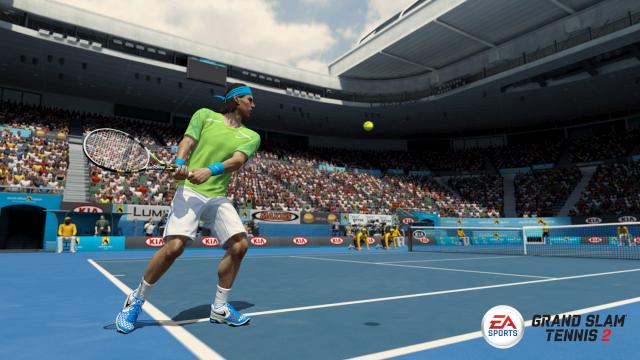
EA Sports are, when you think about it, a pretty remarkable bunch. Looking back at the last 12 months we’ve reviewed games based on Golf, Boxing, American Football, Ice Hockey and “real” Football and they’ve mostly been straight from the top drawer. But each of those titles sits at the recent end of a long line of previous versions stretching back 20-odd years. So up steps EA Canada to try something bold: a title never seen before one of of the two main consoles. Previously served up (pardon the pun) on the Wii to champion the MotionPlus, it’s now been given the royal treatment ready to be launched onto the PS3 complete with Move support, and the 360, interestingly without Kinect capabilities.
So what do you get for your money? Well this is EA, and one thing you can always say about EA games is the amount of polish you’ll find. Teaming up with ESPN means around the FIFA-esque clean menus are replays and TV overlays bearing the badge of ESPN, giving a good illusion of a real game being played out on your TV. The commentary features John McEnroe and Pat Cash, who chip in with helpful criticisms and tips about various parts of the game, and for a little while this is great and really makes the matches more entertaining. But this doesn’t last long, and very soon the commentary gets repetitive, with the same bit of advice often being offered up several times in a single set. Seriously Mr McEnroe, I know there are no cons to hitting your shots closer to the baseline, you’ve told me that 54 times already in the last half hour. This is a huge shame, and a huge surprise given just how great EA’s commentaries tend to be.
Commentary aside, the sound is great, with realistic shots, grunts, squeaks and crowd noises all combining in DTS Surround Sound to put you right in the middle of the court while you’re playing. There were the odd moments when the crowd gave no reaction to a point ending, even when a 30-shot rally ended with a full stretch passing shot down the line, but generally interesting moments will result in a suitable response from the crowd. Visually it’s a similar story, with player models looking brilliant and the courts and stadiums giving a stark difference between the main courts and smaller ones when you hit the main tournaments. There’s a few generic movements and shots that creep in, but generally everything benefits from one of EA Canada’s new toys: P.R.O. AI.

P.R.O. AI intends to make the players as realistic as possible, giving each of the 20-odd tennis legends their own individual style, animations and strengths. On the whole, this works really well. Pete Sampras receives a serve with his bent-over swaying; Andy Murray thumps backhands back at his opponent with two hands… and it all goes towards a more immersive experience, right up until the point you ramp up the difficulty and everyone becomes a net player. It’s easy to see why – playing at the net is a far easier way to win points in this game after all – but when some players in real life barely move away from the baseline it’s odd to suddenly see them dashing into the net as soon as they can.
And yet, the game is still a joy to play. If you haven’t heard of the new total racquet control then you won’t know how you can make every shot, be it a thumping top spin shot or a subtle sliced drop shot, with nothing but the right analogue stick. In a move similar to the likes of Skate 3 or NHL 12, a range of motions of the right stick will give you complete control over the type, power and direction of your shot. It’s a bitch to get the hang of, but once you do it’ll become second nature and you’ll soon be running one way while hitting shots the other and dropping your returns into the exact spot you intend. That is apart from the top spin shots, which seem unnaturally difficult to get down the lines and tend to gravitate more towards the centre of the court. There’s a tutorial on offer to help you learn how to use the system (complete with a silver trophy when you’re done, that’s how tough it is to learn) and the option to use the face buttons in a more arcade style Virtua Tennis type way is always there if you fancy using that instead – in fact both systems work at the same time, so you can switch mid-point if needs be.
If you fancy being a bit more active then you’ll want to grab your Move controller. Grand Slam Tennis 2 has some great Move support, the kind that a lot of people really wanted when the Move was released but has seldom been actually seen in the wild. By taking your shots at different angles, moving the controller in various ways and at various angles you can hammer your shots back with various levels of spin and in whichever angle you want. Again, it takes a fair amount of getting used to, and for the first few games you’ll be plopping random shots back over the next with less power than your average 3 year old. But stick with it, and whether you use the automatic movement option or opt for the navi controller (or left stick of the DS3) to move your player around it works out well eventually.

There’s loads of options when it comes to getting your balls out and bashing them about the place. Alongside a single exhibition match you can take part in a 10 year career, starting with a lowly base player (that in true EA style is insanely customisable, although not quite to FIFA levels) and working your way up by taking part in training sessions and tournaments. Being able to take a fairly feeble player and mould them into your own style to take on the world’s finest is a great way to play, although it’s pretty limited once you get beyond the first year. With only 4 main tournaments and 4 mini-tournaments you’ll end up doing the same thing for 10 years in a row which, when you think of how epic this mode could’ve been, is a little disappointing. There’s also a set of Grand Slam Classics – a series of scenarios from history where you need to perform a certain outcome in order to move onto the next, much like the Madden Moments found in the Madden series. These are a great addition, but as you need to win each one before moving on to the next it’s not easy to see the full range straight away which is a bit of a shame.
You can also jump online and take part in a few different modes, including the interesting Grand Slam Corner, where you have a rank for each location that goes up and down depending on how well you do in each match. Along with the tournaments that contribute towards your nation’s ranking there’s a couple of quite novel ideas here that make life more interesting than the usual one-off singles/doubles match (which, as it goes, is also an option). Playing the games themselves is a good experience, with no lag to speak of, but getting a game in the first place isn’t easy at the moment – out of all the times we dived online there was never more than 85 players currently online. This might go up in the following weeks, but right now it’s tricky to enjoy everything the game has to offer online.
So Grand Slam Tennis 2 is pretty good, although it’s a story of buts. The analogue control system works well, but it’s a little too tough to hit the corners much of the time. The player animations and likenesses are very impressive, but in cut-scenes and some ground shots you’ll sometimes wonder if it’s the same animation with a different face. The sound is great, but the commentary really gets on your tits after a short while. Being able to play in all 4 Grand Slam tournaments is a first in any tennis title, but the career mode lets itself down with a lack of varied content. It’s a tricky one to judge; it’s not the perfect game but for sport fans it’s genuinely good fun with very good Move support, and if you fancy something a little different to your average FPS or racing game then you can do a lot worse. With some polish, the next version could be very spectacular.
Reviewed on PS3


I really enjoyed the demo, but will probably wait for it to go cheap, which given EA Sports titles, probably won;t take too long 🙂
Unlike NHL 12 which is holding its price well after 6 months since being released!